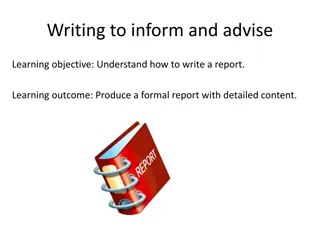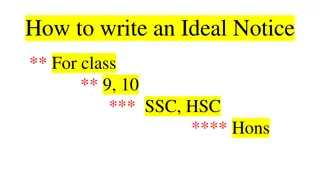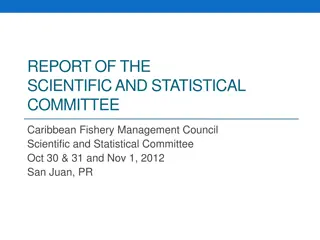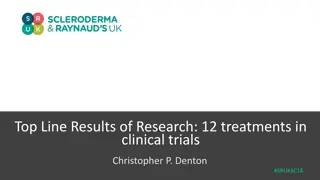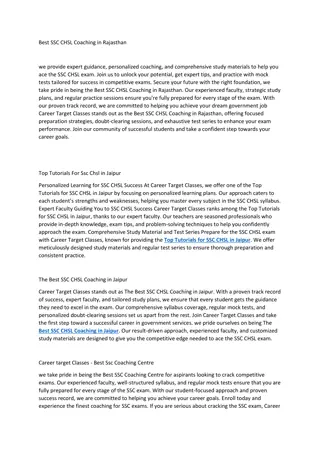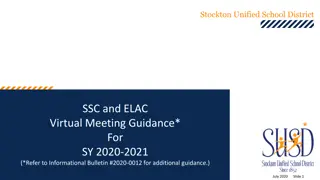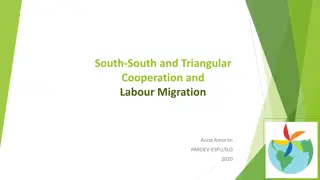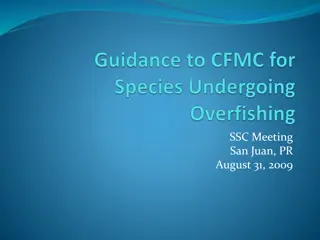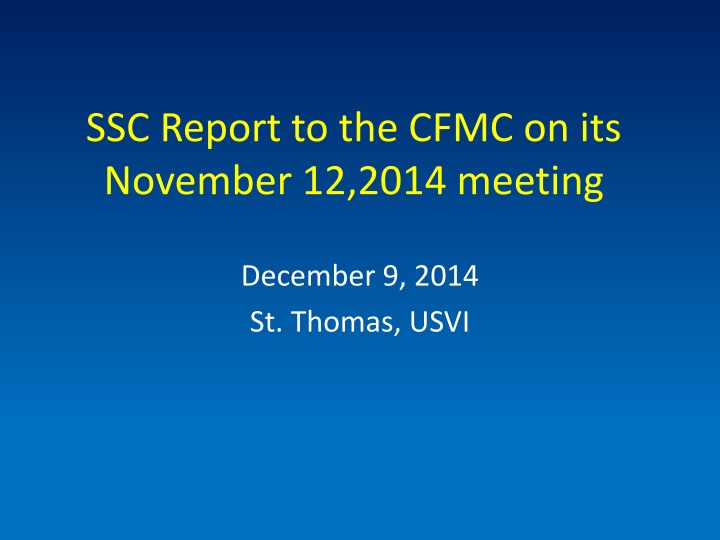
SSC Report on CFMC Meeting Nov 12, 2014 in St. Thomas, USVI
Explore the SSC report to the CFMC regarding overages in Puerto Rico's recreational and commercial fishing sectors in 2010-2013. The report also covers ACL overages for different species, SEDAR review, and analysis of fishing practices in Puerto Rico, St. Croix, and St. Thomas. The SSC findings shed light on stock status, overfishing probabilities, and the impact of fishing closures on fish population sizes.
Download Presentation

Please find below an Image/Link to download the presentation.
The content on the website is provided AS IS for your information and personal use only. It may not be sold, licensed, or shared on other websites without obtaining consent from the author. If you encounter any issues during the download, it is possible that the publisher has removed the file from their server.
You are allowed to download the files provided on this website for personal or commercial use, subject to the condition that they are used lawfully. All files are the property of their respective owners.
The content on the website is provided AS IS for your information and personal use only. It may not be sold, licensed, or shared on other websites without obtaining consent from the author.
E N D
Presentation Transcript
SSC Report to the CFMC on its November 12,2014 meeting December 9, 2014 St. Thomas, USVI
ACL Overages Puerto Rico Recreational No overages Puerto Rico Commercial 2010 species Parrotfishes, Conch, Snappers, Groupers Snapper unit 2 (Queen, Cardinal Snapper) 170% of ACL Does not include 2013 data 2010 was the high year, so should drop
ACL Overages Puerto Rico Commercial 2011 species Wrasses (Hogfish, Spanish Hogfish) 114% of ACL Does not include 2013 data
ACL Overages St. Croix (full data) Angelfish, Squirrelfish, Wrasses are over St. Thomas (full data) Angelfish, Squirrelfish, Wrasses are over
ACL Overages Based on the limited data available and that these species (Angelfishes, Squirrelfishes, Wrasses) were not on the reporting lists until July 2011 for St. Thomas/St. John and St. Croix , and that there is no scientific basis for determining otherwise, the landings overages are assumed to result from enhanced reporting. This applies to the data from 2011 to 2013.
SSC Review of SEDAR 35 (Red Hind)
Puerto Rico The SSC accepts the general outpput of the analyses, which showed a decrease in mortality in the 1990s, but we recognize that it is difficult to determine what is the current status because that would require using absolute values for the parameters. However, given that CFMC defines overfishing as SPR 20% and given that the SEDAR chose to use more conservative values, and the probability of overfishing is less than 50% suggests that there is no strong evidence of undergoing overfishing in Puerto Rico.
St. Croix The low sample sizes available to estimate mean length in recent years precludes any determination of stock status or probability of overfishing
St. Thomas The SSC believe that due to the closures in the 1990s, fishers moved from fishing at the aggregations, where large fish were readily available, to fishing other sectors of the red hind population (other locations) where these larger individuals were not readily available. Therefore, this resulted in a reduction in size of fish due to change in location rather than increased in mortality. This could be checked by examining the data during the spawning and non-spawning periods.
Model/Approach Recommendations The SSC agrees with most of the comments of the CIE reviewers on how to improve the assessment, but in evaluating these comments the SSC feels that overall the approach used by the SEDAR 35 were valid. CIE recommendations to improve the analysis were incorporated into the subsequent research recommendations
Model/Approach Recommendations The SSC accepted the explanations from the SEDAR working group that Surplus production models were data limited Reliable projections were not possible given data and viable approaches used Age/slicing: having problems with length of data sets then not valuable approach Length-based method used seems to be most appropriate given limitations of data, but it is recognize that this model has its own limitations, which are addressed in the research recommendations.
Research Recommendations Accept list of research recommendations, which are as follows: Basic fish biology research (e.g., age, growth, diet, length/age-at-maturity, fecundity) Gear selectivity studies Discard studies Continued improvement of data collection programs
2015 National SSC Meeting February 23-25, Honolulu ABC specification for data-limited and model- resistant stocks Implementation of National Standard 2 in the face of uncertainties Evaluating existing ABC control rules: issues, challenges and solutions Incorporating ecological, environmental, and climate variability in stock assessment and ecosystem based fishery management Building habitat condition in the stock assessment process and fishery management strategies
5-Year Research Plan Stock Status Assessment of the Effects of Current Federal Management Regulations Ecosystem Based Research: Watershed Approach, Large Spatial & Temporal Scale Studies Fishery Associated Human Communities New & Alternative Sampling Techniques Draft plan is uneven and in some areas unfocused First step is top provide summary statements for each area to provide target goals so that research priorities are properly focused.
Species Selection Criteria Island-based FMPs Concept of Thresholds Are there upper and lower thresholds (lbs,$) for inclusion and/or exclusion of species? Where would thresholds be applied? Can concept of Ecosystem Component Species be applied? Habitat Specificity Range Target Species Ecological Value Protected/Managed Resource Economic Importance Yearly Mean Landings Bycatch
Species Selection Criteria Concept of Thresholds St. Thomas/St.John 101 species (or groups) St. Croix 99 species Puerto Rico Commercial 174 species Recreational 226 species All included species need ACLs
Species Selection Criteria Concept of Thresholds Example: Puerto Rico commercial landings 48 species within 99% cumulative landings 125 species above 99% Those above range from 3,000 lbs to 1 lb average But include Nassau, goliath, yellowfin & yellowedge groupers Rainbow parrotfish Cubera, dog, gray, schoolmaster & mahogony snappers Sharks and rays Problems with FMUs and data at family level








